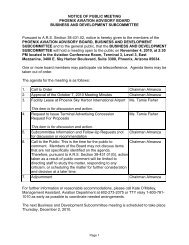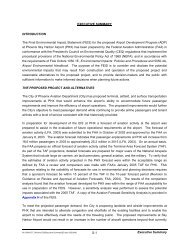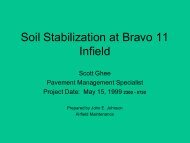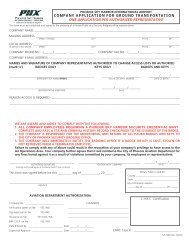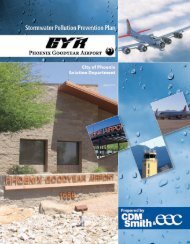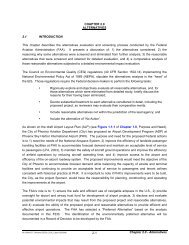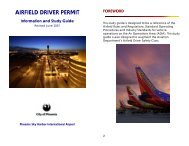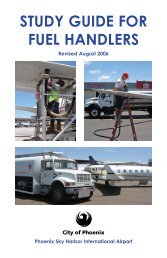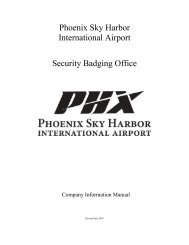How is a Noise Exposure Map - Phoenix Sky Harbor International ...
How is a Noise Exposure Map - Phoenix Sky Harbor International ...
How is a Noise Exposure Map - Phoenix Sky Harbor International ...
Create successful ePaper yourself
Turn your PDF publications into a flip-book with our unique Google optimized e-Paper software.
Frequently Asked Questions<br />
What are No<strong>is</strong>e <strong>Exposure</strong> <strong>Map</strong>s (NEMs)?<br />
No<strong>is</strong>e <strong>Exposure</strong> <strong>Map</strong>s (NEMs) identify the no<strong>is</strong>e exposure of the current operating conditions,<br />
and projected future conditions. Included within th<strong>is</strong> analys<strong>is</strong> <strong>is</strong> the operating conditions at the<br />
airport including departure and arrival procedures, daytime and nighttime activity, touch and go<br />
operations and helicopter activity. Aircraft no<strong>is</strong>e <strong>is</strong> depicted on the NEMs as no<strong>is</strong>e contours,<br />
which show the average no<strong>is</strong>e levels around the airport.<br />
What <strong>is</strong> a No<strong>is</strong>e <strong>Exposure</strong> <strong>Map</strong> Update?<br />
A No<strong>is</strong>e <strong>Exposure</strong> <strong>Map</strong> Update <strong>is</strong> designed to identify no<strong>is</strong>e sensitive land uses surrounding an<br />
airport for ex<strong>is</strong>ting conditions and for five years in the future. For the purposes of <strong>Map</strong> Updates,<br />
no<strong>is</strong>e sensitive land uses are generally defined as residences or public use facilities (libraries,<br />
places of worship, schools, nursing homes and hospitals) within the 65 Day-Night Average<br />
Sound Level (DNL) no<strong>is</strong>e contour, the area the FAA defines as impacted by aircraft no<strong>is</strong>e.<br />
<strong>How</strong> <strong>is</strong> a No<strong>is</strong>e <strong>Exposure</strong> <strong>Map</strong> Update Different from a Part 150 Study?<br />
Like No<strong>is</strong>e <strong>Exposure</strong> <strong>Map</strong> Updates, Part 150 Studies identify no<strong>is</strong>e sensitive land uses<br />
surrounding an airport. <strong>How</strong>ever a Part 150 Study also recommends measures to both correct<br />
ex<strong>is</strong>ting incompatibilities and to prevent future incompatibilities. Both a No<strong>is</strong>e <strong>Exposure</strong> <strong>Map</strong><br />
Update and a Part 150 Study are guided by Federal Aviation Admin<strong>is</strong>tration regulations found<br />
in14 CFR Part 150.<br />
What <strong>is</strong> the Integrated No<strong>is</strong>e Model?<br />
The FAA has developed the Integrated No<strong>is</strong>e Model (INM) for evaluating aircraft no<strong>is</strong>e impacts<br />
in the vicinity of airports. The INM has been the FAA's standard tool since 1978 for determining<br />
the predicted no<strong>is</strong>e exposure in the vicinity of airports. The INM has been updated many times<br />
since 1978 to include improved metrics and current aircraft databases. The FAA requires the use<br />
of INM to develop no<strong>is</strong>e exposure contours in No<strong>is</strong>e <strong>Exposure</strong> <strong>Map</strong> Updates. The INM utilizes<br />
flight track information, types of aircraft using the airport, aircraft flight profiles, runway use and<br />
terrain as inputs. The INM produces no<strong>is</strong>e exposure contours measured in DNLs that are used for<br />
land use compatibility maps.<br />
What <strong>is</strong> the purpose of no<strong>is</strong>e monitoring in a No<strong>is</strong>e <strong>Exposure</strong> <strong>Map</strong> Update?<br />
Field measurements from the airport's permanent monitoring system and the temporary monitors<br />
establ<strong>is</strong>hed as part of the <strong>Map</strong> Update were collected. The measurements were compared with<br />
pre-ex<strong>is</strong>ting database information related to aircraft no<strong>is</strong>e level and performance character<strong>is</strong>tics<br />
in the FAA's Integrated No<strong>is</strong>e Model. The information collected during the measurement<br />
program included acoustical output as well as flight track data (the aircraft's three-dimensional<br />
location) relative to the no<strong>is</strong>e measurement site. Th<strong>is</strong> information was used to ensure that the<br />
input data into the Integrated No<strong>is</strong>e Model was as accurate as possible.
What <strong>is</strong> DNL?<br />
The Day-Night Average Sound Level metric describes the total no<strong>is</strong>e exposure during a given<br />
period. DNL <strong>is</strong> a metric used for predicting the average long term no<strong>is</strong>e exposure on a<br />
population. In computing DNL, an extra weight of 10 decibels (dB) <strong>is</strong> assigned to any sound<br />
levels occurring between the hours of 10:00 p.m. and 7:00 a.m. Th<strong>is</strong> <strong>is</strong> intended to account for<br />
the greater annoyance that nighttime no<strong>is</strong>e <strong>is</strong> presumed to cause for most people. Th<strong>is</strong> extra<br />
weight treats one nighttime no<strong>is</strong>e event as equivalent to 10 daytime events of the same<br />
magnitude.<br />
Can the City of <strong>Phoenix</strong> restrict operations at <strong>Phoenix</strong> <strong>Sky</strong> <strong>Harbor</strong> <strong>International</strong> Airport?<br />
No. The FAA <strong>is</strong> the only entity that can manage aircraft runway operations or aircraft in flight at<br />
<strong>Phoenix</strong> <strong>Sky</strong> <strong>Harbor</strong> <strong>International</strong> Airport. Furthermore, as a recipient of grant funds from the<br />
FAA, the City of <strong>Phoenix</strong>, operator of the Airport, must abide by specific FAA-imposed<br />
obligations and conditions. One of these <strong>is</strong> that the City of <strong>Phoenix</strong> will not restrict or limit<br />
airfield access based on no<strong>is</strong>e.



